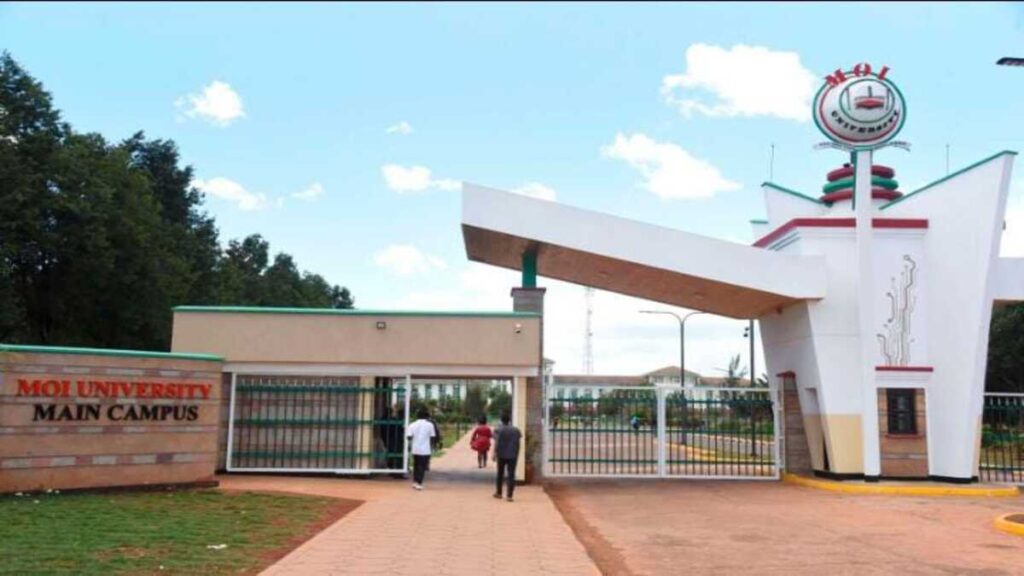In recent months, Moi University has faced a severe financial crisis that has led to its indefinite closure and a strike involving over 4,000 staff members. This turmoil has roots that extend back several years, with the university’s financial difficulties becoming increasingly apparent since 2021. The Auditor-General reported that the institution was technically insolvent, with debts exceeding Ksh 8 billion (approximately £56 million) due to mismanagement and declining student enrolment.

A Photo of the Gate of Moi University In Eldoret
The situation escalated dramatically on October 3, 2024, when staff began striking over unpaid salaries and the failure to implement a Collective Bargaining Agreement (CBA) established in 2013. Lecturers and administrative staff had not received their salaries for months, leading many to default on loans and face severe financial hardships. The university’s monthly capitation from the government had been slashed from Ksh 203 million to Ksh 89 million, making it impossible to meet payroll obligations.
Dr. Humphrey Njuguna, the chairperson of the university council, acknowledged the dire financial state of Moi University. He attributed the crisis to several factors: the closure of satellite campuses, a bloated workforce, reduced student numbers—from 50,000 in 2015 to about 27,000—and diminished government funding. To address these issues, the university has sought alternative revenue streams, including agricultural projects on its 100-acre farm.
Despite efforts to negotiate a resolution with staff unions such as the University Academic Staff Union (UASU) and the Kenya Universities Staff Union (KUSU), talks have repeatedly ended in stalemates. On November 6, just one day before a planned reopening, management announced that negotiations had failed and that reopening would be postponed indefinitely. This announcement left students and staff in limbo, unsure of their academic futures.
The unrest among students grew as frustrations mounted over the prolonged closure. Many students were forced to vacate campus premises amid fears of losing their academic year. Demonstrations erupted as students demanded clarity from university management regarding their future and the status of their education.
In response to the crisis, Dr. Beatrice Muganda Inyangala, Principal Secretary for Higher Education and Research, announced that officials would visit Moi University on November 8 to assess the situation. She urged students to remain patient while the institution worked towards a resolution. However, many were sceptical about whether any meaningful change would come from these interventions.
The financial mismanagement at Moi University has drawn scrutiny from various stakeholders, including members of Parliament who have called for a forensic audit of the institution’s finances. The National Assembly’s Public Investment Committee on Education has tasked the Auditor-General with investigating the university’s financial dealings over the past five years. This inquiry aims to shed light on how funds were mismanaged and why critical payments—such as payroll deductions—were not remitted.
As reports of ghost workers surfaced—allegations that some staff members listed on payroll did not exist—the university’s reputation further deteriorated. Dr. Njuguna denied these claims but acknowledged that investigations were necessary to restore trust in the institution’s administration.
In an attempt to alleviate some immediate financial pressure, the National Treasury pledged Ksh 2.9 billion to support Moi University’s operational needs. However, this funding is merely a temporary fix in light of ongoing structural issues within the institution’s financial framework.
The future of Moi University hangs in balance as it grapples with its mounting debts and operational challenges. The ongoing strike highlights broader issues within Kenya’s public universities regarding governance, funding models, and accountability. As stakeholders continue discussions aimed at resolving these crises, there is hope that meaningful reforms will emerge from this turmoil—reforms that could ultimately safeguard the future of higher education in Kenya.
For now, students remain in uncertainty while faculty members face mounting pressures from creditors and personal financial obligations. The hope is that through collective action and government intervention, Moi University can navigate this storm and emerge stronger for its community—a community that relies heavily on it for educational advancement and personal development.